
{Updated: July 23, 2021 with information from Google about broad core updates being unrelated to Core Web Vitals and the Page Experience Signal.}
{Updated: August 6, 2021 with information from Google’s John Mueller that the June and July broad core updates were separate and unique.}
{Update July 2022: I just published my post covering the May 2022 broad core update containing five micro-case studies of drops and surges.}
—————-
Welcome to Google Land.
Please keep hands, arms, and legs inside the vehicle at all times. :) Yes, the spectacular summer of Google algorithm updates continues. This has been one of the most volatile few months I can remember from an algorithm update standpoint. First, Google rolled out the Product Reviews Update in April, which was followed by the June broad core update (when Google also explained a second core update would be rolled out in July). Then the much-anticipated Page Experience Update rolled out in mid-June. After that, Google rolled out two spam updates on 6/23 and 6/28, followed by the July 2021 broad core update on 7/1.
Google has been busy, that’s for sure. For the most part, it’s felt like this:

In this post, I’m going to cover findings based on the July 2021 broad core update, and its sibling core update that rolled out in June. There are many sites that saw impact during both broad core algorithm updates, so it makes sense to document what I’m seeing across both. And that includes some reversals (which Google explained could happen with the July update). Remember, Google explained that some improvements weren’t ready for the June core update and that’s why there would be a second core update in July. That’s unusual… and Google didn’t explain more about that (for obvious reasons).
Rapid-fire insights from a double core update:
In this post, I’ll provide a list of rapid-fire insights based on what I’m seeing across sites impacted. First, here’s a quick table of contents in case you want to jump around the post.
Table of contents:
- Rollout of July and June core updates.
- Time to see impact.
- Reversals from June.
- The June and July core updates were separate and unique.
- Tremors.
- Health and medical sites.
- Finance sites.
- Sites with the same, or near-duplicate, content.
- Category adjustment based on Product Reviews Update flaw.
- Reversals from previous broad core updates.
- Product Review sites.
- Spam updates.
- Rich snippets impact.
- A note about Core Web Vitals.
- The “Kitchen Sink” approach to remediation.
- Site-level quality signals.
- Final tips and recommendations.
Rollout of the June and July broad core updates:
The June update started rolling out on 6/2 and finished rolling out on 6/12. That was pretty quick for a broad core update, which can sometimes take up to 14 days to fully roll out. The July broad core update started rolling out on 7/1 and completed rolling out on Monday, 7/12. So, the July update took 12 days to fully roll out, closer to what we normally see with broad core updates.
And I have to mention the dates of other Google algorithm updates rolling out since early June. Site owners should know these dates to make sure they are seeing movement from the broad core updates and not the others. Google started to roll out the much-anticipated Page Experience Update on 6/15, but that will roll out slowly and it won’t fully complete until the end of August. Also, Google explained the Page Experience Signal will be a lightweight factor (more of a tiebreaker). So, if you are seeing significant movement in June and July, it’s probably not from the Page Experience Update.
Here is a slide from my SMX Advanced presentation about the power of the signal (along with a tweet of mine based on a video from Google’s Martin Splitt):
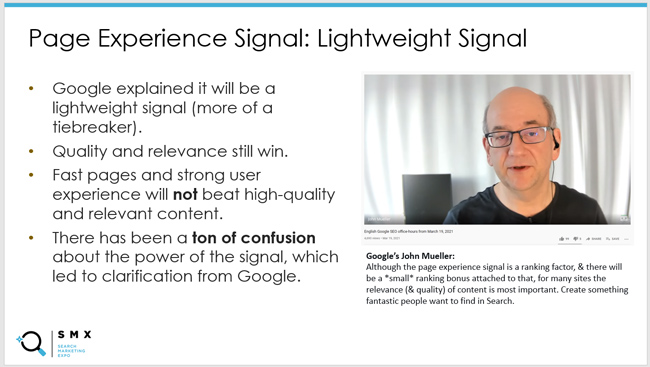
There were also two spam updates that rolled out on 6/23 and then 6/28, and I have seen several sites impacted by those updates. I’ll cover more about that in my post, especially sites that were impacted and then also saw movement during the double core updates in June and July.
Time to see impact from the broad core updates: Slower in June, quicker impact in July.
When a broad core update rolls out, we typically see movement pretty quickly (within 24-36 hours after the rollout begins). The June broad core update was different… we didn’t see movement until a few days into the rollout for some reason. The first movement I saw was 6/5 into 6/6. I tweeted about that once I saw a lot of volatility across sites.
Here is GSC trending for a client of mine that started seeing a surge on 6/6:

And on the flip side, we saw volatility very quickly with the July broad core update (within 24 hours of the rollout). That’s similar to what we have seen with other broad core updates. I also tweeted when I started seeing the early movement.
Also, and I’ve covered this in other posts about broad core updates, but it’s important to analyze the queries and landing pages dropping based on a broad core update. There could be several reasons for the drop, including relevancy adjustments, intent shifts, overall site quality problems (or a mix of reasons). You can read my post about this topic for more information.
June reversals in July. We were warned about this…
When the June 2021 broad core update rolled out, Google explained that some sites could see reversals with the July 2021 broad core update. Needless to say, I was interested in seeing how that would go. I also tweeted that nobody should declare victory with the June core update until July fully rolls out. And after the July broad core update started rolling out, I saw some sites reverse course. There weren’t a ton of reversals based on the sites in my dataset, but there were quite a few.
Here are some examples of visibility changes for sites that saw reversals (either surging, then dropping, or dropping, then surging):

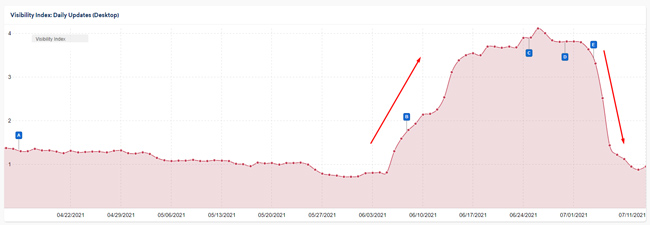

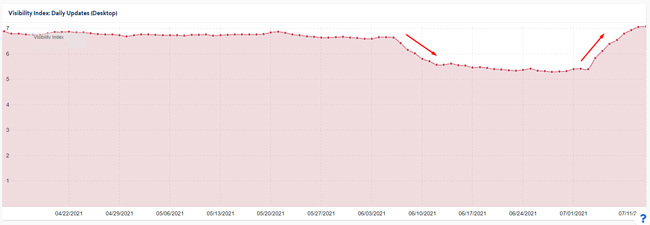
Google: The June and July Core Updates Were Separate and Unique.
Based on some sites seeing impact during one update, and not the other, Google’s John Mueller was asked a question about that during a Search Central Hangout video. John explained that the June and July core updates were separate and unique updates. And just because they are both “core updates” doesn’t mean they affect the same core parts of the ranking system. That’s why some sites can see impact during one of the core updates, but not the other. Here is John explaining this (at 30:25 in the video):
Tremors: Not a surprise, just like with other major algorithm updates.
After major algorithm updates roll out, it’s not unusual for Google to make smaller tweaks to the algorithm based on what they are seeing in the SERPs. You can think of them as minor adjustments to fine-tune the results. Google’s John Mueller explained this publicly back in medieval Panda times. Well, we definitely saw tremors during the July broad core update (especially near the end of the rollout). Here are two examples of sites seeing changes starting around 7/9.

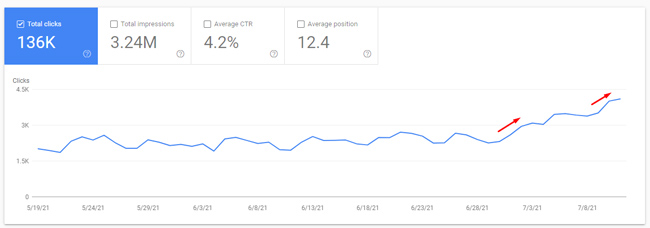
Is there a doctor in the house? A reminder that Google’s algorithms can be more critical of health/medical content:
With many broad core updates, there can be a lot of volatility across sites categorized as Your Money or Your Life (YMYL). And within that category, health and medical can often see a lot of movement. Google is on record explaining that its algorithms are more critical with health and medical content (for obvious reasons).
Here is a tweet I shared based on a video from Google’s John Mueller explaining more about health and medical. And here is a direct link to the video if you want view it now (starting at 20:25 in the video):
Well, I saw some very big swings across some health and medical sites with the June and July core updates. There were some sites with huge changes in search visibility… Note, it’s impossible to know what Google exactly changed since there are so many factors being evaluated. In my opinion, you will rarely be able to isolate specific changes to Google’s algorithms (for broad core updates). It’s more important to keep improving your site overall, and I’ll cover the “kitchen sink” approach to remediation later in this post.
For example, here are some examples of big visibility changes for health/medical sites:





Take the money and run. Also a lot of volatility across some financial sites.
While we’re on the topic of YMYL content, I also saw a lot of big swings in search visibility across sites focused on finance. Since those sites are considered YMYL, Google’s algorithms hold them to a higher standard. And some of the sites saw a lot of movement with the summer set of core updates.
For example:


Sites with the same, or near-duplicate, content: Reference, lyrics, directories.
I have previously covered sites that contain the same, or very similar, content before. For example, reference sites, lyrics sites, directories, etc. Google has explained that if you provide the same content as many other sites, and don’t provide a serious value-add, then it can be hard for Google’s algorithms to decide which sites should rank highly. I have seen this many times over the years and have helped a number of sites in verticals like these. It’s easy for sites that don’t provide a value-add to surge and drop during each broad core update (as Google struggles to determine which ones should rank higher…)
With the June and July core updates, I saw a lot of movement across sites that fit into these categories. Again, it’s extremely important to provide a serious value-add (especially when the content is the same, or near-duplicate). If you don’t provide a value-add, then you could surge during one update, and drop heavily during the next. And that leads to roller coaster trending (which can drive site owners insane).
Here are some examples of sites that fit into this category that saw a lot of movement:
Large-scale reference sites:


Lyrics sites seeing a lot of movement:




Interesting: Category adjustment based on a Product Reviews Update flaw?
Continuing down the path of trends I saw during the June and July core updates, there was a lot of sites within one specific vertical that did not fare well with this update. I have a done a lot of work in that space over the years and it was clear that Google implemented big changes on that front. I’m not saying all sites in the niche dropped heavily, but a number of sites did (including some of the top players).
This could have started when Google took a hard look at the vertical after the Product Reviews Update (PRU). With that update, some sites that don’t provide reviews content surged for queries that fell outside of their focus. I can’t go into too much detail about this, but Google’s algorithms incorrectly caused those sites to surge during the PRU. So, I knew it wouldn’t be long for them to implement changes there algorithmically. And those changes could be seen during the June and July broad core updates. I covered more about the collateral improvement I saw in my post about the Product Reviews update.
Here is some trending for those sites during the update(s):



Reversals from previous broad core updates: The gray area of Google’s algorithms.
In my previous posts about broad core updates, I explained a very important point for site owners about recovery. Sites that are heavily impacted by broad core updates typically cannot see recovery until another broad core updates rolls out. There have been a few exceptions, including what I saw with the Product Reviews update, but overall, sites typically need to wait for another broad core update to see recovery (and that’s only if the site has significantly improved in quality over the long-term). You can read my previous posts about core updates to learn more about that.
Here is a slide from my SMX Advanced presentation with information about recovery from Google’s broad core updates (including information from Google’s John Mueller):
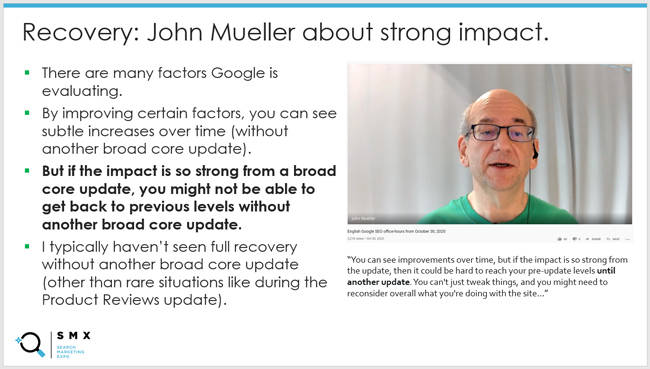
Well, during this update, there were many, many examples of sites that reversed course (big-time) from previous core updates. And for sites that surged during a previous core update only to get hammered during this broad core update, that can often happen when those sites are in the gray area of Google’s algorithms (where they might creep out of the gray area during one update and surge, but drop back into the danger zone during the next update and drop). I’ve explained many times before that the gray area of Google’s algorithms is a maddening place for site owners to live.
Here is an example of a site seeing major volatility during a number of broad core updates:
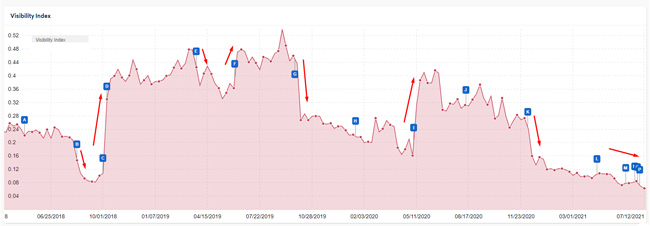
Product Review Sites: Enough is enough
What a few months it’s been for product review sites… We had the Product Reviews Update in April, which was core update-like for many review sites. And then the June and July broad core updates rolled out and some of those sites saw even more impact. And some even reversed course with the June/July broad core updates. It seems the double core updates this summer had even more impact on a number of those sites.
For example, here are some product review sites during the June/July core updates:




And then there were review sites that were unaffected by the Product Reviews Update that saw big gains or drops during the June and July core updates. Here’s a client of mine that has worked extremely hard to improve the site overall (large-scale reviews site impacted by several previous core updates that surged during the June broad core update). This was great to see based on how much work they completed on the site:

Spam Updates + Broad Core Updates. A one-two (or more) punch for some sites.
I mentioned earlier that Google released two spam updates in June (the first on 6/23 and then the second update five days later on 6/28). Most sites didn’t see any impact from those spam updates, but it was big for the ones that did.
And beyond the spam updates, some of those sites saw additional movement with the June and July broad core updates. Some reversed course, some surged, some dropped, etc. It was definitely a crazy few weeks for those sites (getting caught in the spam updates and broad core updates).
For example, here are some sites seeing movement with the spam updates and the June/July broad core updates:



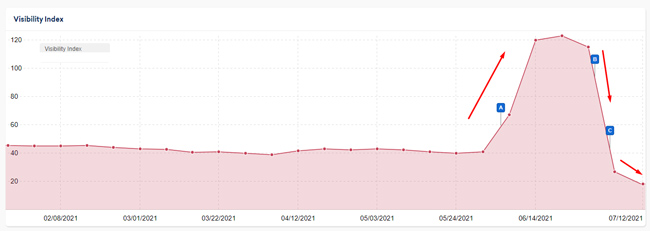

Rich snippets impact: Speak of the devil
My last blog post covered how rich snippets can be impacted by broad core updates, so it was fitting to see that happen during the June/July core updates. If you are interested in learning more about that (and how that can happen), check out my blog post.
Here’s a great example of a site that received rich snippets back after losing them during a previous broad core update (review snippets in this case). This is based on Google’s site-level quality signals (which Googlers have explained before and based on what I’ve seen in the field many times). I’ll cover more about site-level quality signals soon.
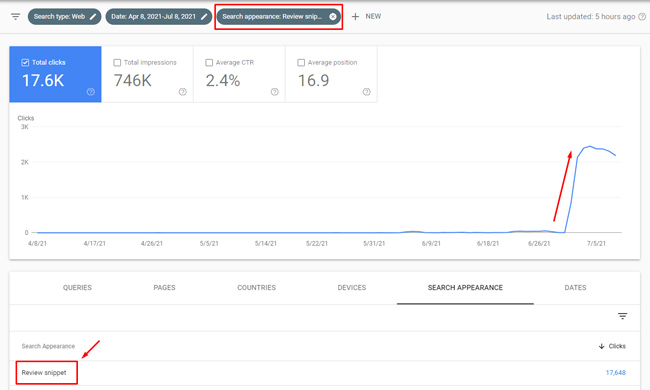
And here are how-to snippets returning for a site during the June broad core update that had them removed during a previous core update:
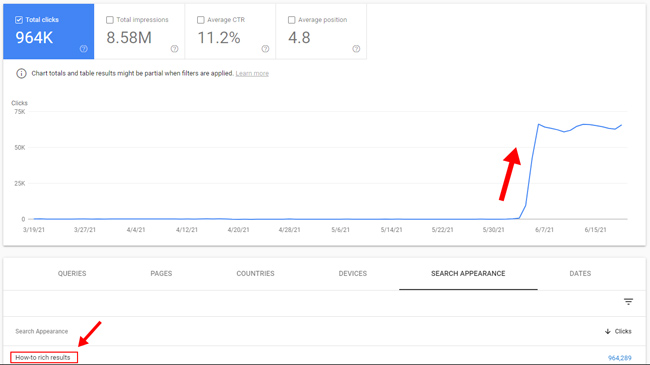
A Note About Core Web Vitals: Correlation vs. Causation
Based on the June/July core update impact, there are some people that speculated that Core Web Vitals were factored in during the summer core updates. For example, many sites that improved during the update had strong Core Web Vitals scores, and some were speculating that those scores were part of the reason they surged. I was asked on Twitter about this as well.
First, I don’t believe Core Web Vitals scores were taken into account during the June and July broad core updates. And I was glad to see Google’s John Mueller confirm that to be the case. You can see the video below for John’s response. But, that doesn’t mean an improved user experience didn’t help those sites. For years I have been saying that Google’s broad core updates take many factors into account, including the user experience. I’ve covered how aggressive and disruptive advertising could impact sites, how user experience barriers could have an impact, how deception could be problematic, and more. So, it makes complete sense that sites improving those areas could see gains during subsequent broad core updates (while also seeing Core Web Vital scores improve).
For example, here’s a slide from my SMX presentation in 2019 where I covered how a negative user experience could contribute to a broad core update hit:
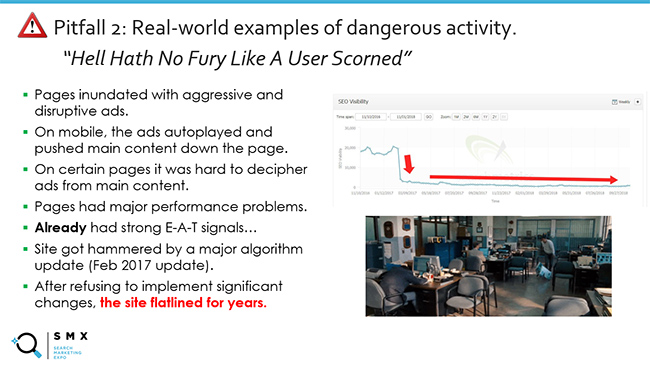
Regarding sites that improved during the July core update, here are the Core Web Vitals scores for two sites that surged during the June core update, but their scores aren’t great. They are ok, and have improved, but they aren’t strong across the board. And keep in mind that the site owners worked on improving their sites overall, including content quality, user experience, the ad situation, technical SEO issues causing quality problems, and more.
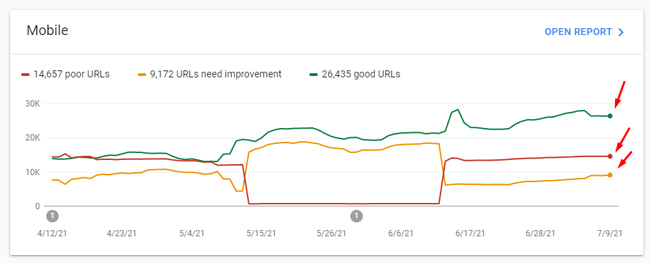
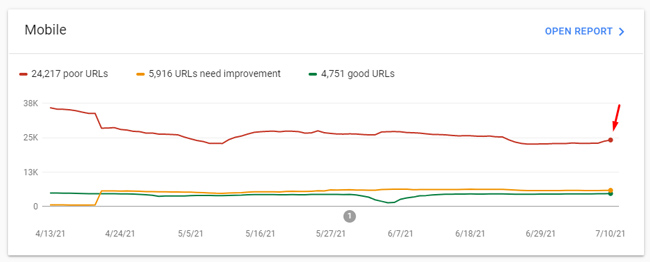
So, I think this is a correlation versus causation situation for sites with strong CWV scores that surged during the June or July core updates. The scores themselves wouldn’t be factored in with broad core updates, but the effect of improving Core Web Vitals could absolutely impact a site during broad core updates. Anyway, just my two cents on the subject. :)
—Update About Core Web Vitals: July 23, 2021—
Google’s John Mueller confirmed in a Search Central Hangout video that broad core updates are unrelated to Core Web Vitals and the Page Experience Signal. John reiterated that broad core updates are about Google evaluating the quality and relevance across a site where the Page Experience Update is about performance. He also explained that if you saw a stark drop or surge, then it’s probably more related to the core updates and not the Page Experience Signal (which includes Core Web Vitals). You can watch the video below at 28:01 in the video:
The “Kitchen Sink” approach to remediation: A strong way forward for site owners.
I have covered what I call the “kitchen sink” approach to remediation many times before in my posts and presentations about broad core updates. Google is evaluating many factors over an extended period of time with broad core updates, so it’s impossible to isolate one or two things that need improvement. I’ve often said there’s never one smoking gun with sites negatively impacted by a broad core update. Instead, there’s typically a battery of them.
That’s why it’s important to thoroughly analyze a site through the lens of broad core updates, surface all potential problems, and fix as many as you can (or all of them in a best-case scenario). Google is on record that they want to see significant improvement in quality over time. And that’s exactly what I’ve seen in the field while helping sites that have been negatively impacted by broad core updates. Surface all potential problems, fix as much as you can, improve the site greatly, etc. That’s your best bet for seeing recovery during subsequent broad core updates.
And no, it’s not easy. There’s usually a lot of work that has to be done. And some of those decisions are extremely hard to make. Beyond that, then you have the execution of those changes, which can be challenging. But again, significant improvement is what Google wants to see. And it can pay off big-time during subsequent broad core updates.
Site-level quality algorithms and site-level impact:
It’s also important to understand that Google has site-level quality algorithms that can have a big impact on rankings across a site. These algorithms can lift rankings overall for a site and not just on a url-by-url basis. I have covered this many times over the years and have documented Google explaining this over time. This is also why it’s important to significantly improve a site overall and not just a few urls. Site owners can miss the forest for the trees if they focus too narrowly (at least for broad core updates). So, think broadly about improving the site, pun intended. :)
Here is just one tweet of many from me about the subject. This links to a video from Google’s John Mueller explaining more about site-level quality signals:
Here are some examples of sites I have helped that took a “kitchen sink” approach to remediation that surged during the June or July broad core updates. They didn’t fix one or two things. They fixed many things that had a huge impact on the site overall. Remediation like this can take months (or longer), but can have a big impact on a site during broad core updates.

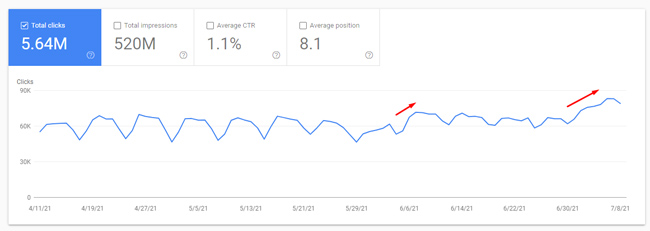
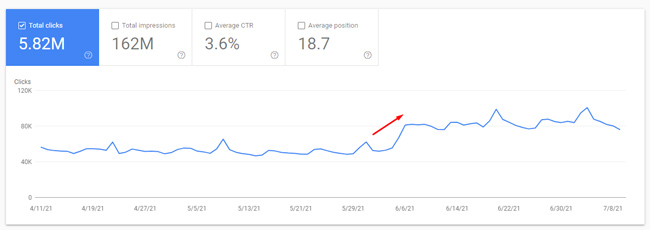
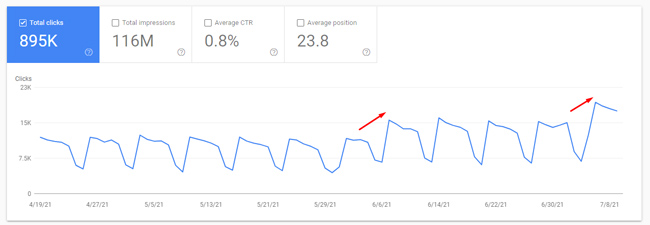
It’s also important to understand that Image Search can be impacted during broad core updates as well. Here is one of the sites I helped that used a “kitchen sink” approach to remediation that also surged in Image Search (in addition to Web Search). For more information about that, you can read my post about how broad core updates can impact Image Search:
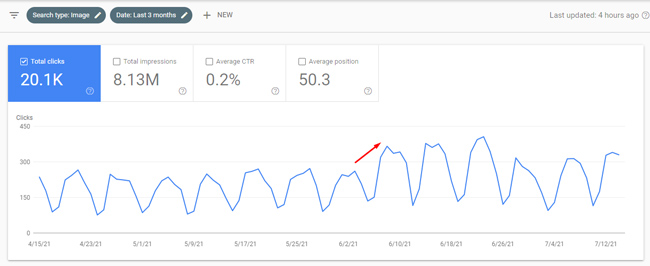
Next steps for site owners impacted by the June and July core updates:
If your site has been heavily impacted by the June or July broad core updates, I have some closing bullets that might be helpful.
- Recovery: First, understand you probably won’t see recovery without another broad core update rolling out. Don’t implement a few changes and expect to see a surge in rankings. That’s not how it works.
- Improvement: Understand that Google wants to see significant improvement in quality over the long-term in order to see recovery. Sure, some sites surge without doing anything during broad core updates, but those sites can stay in the gray area of Google’s algorithms and possibly drop again during subsequent broad core updates. I would work to clearly get out of the gray area.
- Remediation: Take a “kitchen sink” approach to remediation (as covered earlier). There’s usually not one smoking gun on sites heavily impacted by broad core updates. Instead, there’s typically a battery of them. Surface all potential problems and fix them all (or as many as you can).
- User Studies: Run a user study through the lens of Google’s broad core updates. I usually cover this after every broad core update rolls out, since it’s super-powerful. I know it sounds like a pain in the neck to run a user study… but the feedback is pure gold for improving a site, the user experience, the content, and SEO overall.
- Drive Forward: Keep driving forward. Don’t wait to publish new content or implement improvements to the site. The quicker you can improve the site, the content, the user experience, etc., the better. Again, that’s what Google wants to see. Unfortunately, there are many sites that see continuous drops during broad core updates until they significantly improve things. I have documented some of those situations in my case studies about broad core updates. The sooner you can improve, the sooner you can recover during subsequent broad core updates.
- User Experience: Improve the user experience on your site. Don’t bombard users with ads, annoy them with unnecessary popups, notifications, and more. I mentioned Core Web Vitals and how improving those scores can have a secondary effect during broad core updates. In my posts and presentations about broad core updates, I’ve often said, “hell hath no fury like a user scorned”. I’ve seen this over and over when analyzing sites that were negatively impacted during broad core updates and I believe this will only continue. Create happy users. Good things can happen.
- Value-add: Make sure to provide a value-add (especially if you provide content that can easily be found elsewhere on the web). If you don’t provide a value-add, then Google’s algorithms can have a hard time understanding which site to rank highly (or at all). You can end surging and dropping during broad core updates (yo-yo trending over time). Invest in providing more value to users than your competitors. Prove to Google you should rank over those sites.
Summary: The Spectacular Summer of Google Algorithm Updates Continues…
I hope my rapid-fire list of insights based on the June and July 2021 broad core updates was helpful. One thing is for sure. It’s been a crazy few months from an algorithm update standpoint, and we’re not done yet. The Page Experience Update is still rolling out and should fully roll out by the end of August. And from a broad core update standpoint, I think the soonest we would see another is in the fall. It’s hard to say if Google will roll one out then, but site owners should start working on improvements sooner than later. Remember, you will typically need another broad core update to roll out to see recovery (as covered earlier). And that’s only if you significantly improve quality over time. Good luck.
GG


